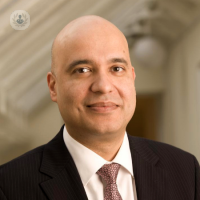Could tonsil stones be responsible for your bad breath?
Written by:If you are suffering from frequent problems with bad breath, you likely haven’t considered that tonsil stones could be responsible. These deposits in the pockets and folds that occur naturally in the tonsils are relatively common, despite not usually being discussed. In this article, leading ear, nose and throat specialist Professor Guri Sandhu expertly explains the causes, symptoms and treatment options for tonsil stones.

What are tonsil stones?
Tonsilloliths, also known as tonsil stones, are white or creamy deposits in the tonsils and are formed when there is mineralisation of the material that is caught in the tonsillar crypts, the pockets and folds found on the tonsils. This material may contain food or dead skin, together with bacterial biofilms. As well as an association with chronic bacterial or fungal build-ups, tonsil stones may be linked to recurrent infections.
What are the symptoms of tonsil stones?
About ten per cent of the population will have tonsil stones, but most people have no symptoms and they are usually an incidental finding on examination. Sometimes patients report bad breath in connection with tonsilloliths, or if the stones are particularly large their presence may be felt.
When should I see a doctor?
If you believe the tonsil stones are causing bad breath and you wish to discuss treatment, then you should seek a referral to an ENT surgeon.
If you have a persistent pain in your throat, especially if it localises to one side, this is unlikely to be related to tonsil stones and you should see your family doctor in the first instance.
How do you treat tonsil stones?
If there are no symptoms then they require no treatment. Otherwise gargling with warm salty water or manual removal could be tried.
With persistent or recurrent tonsilloliths, surgery may be considered. Tonsillectomy (removal of the tonsils) is the definitive solution to this problem but the procedure is associated with post-operative pain and a small risk of bleeding during the first two weeks following surgery.
Laser reduction of the surface of the tonsils can remove the crypts and crevices (cryptolysis) where tonsil stones form. This is most commonly performed using a carbon dioxide laser. This technique is associated with less pain and fewer complications. However, future sore throats may lead to the tonsils enlarging again and the crypts reforming.
If you are worried about tonsils tones and would like to book a consultation with Professor Sandhu, you can do so by visiting his Top Doctors profile.


